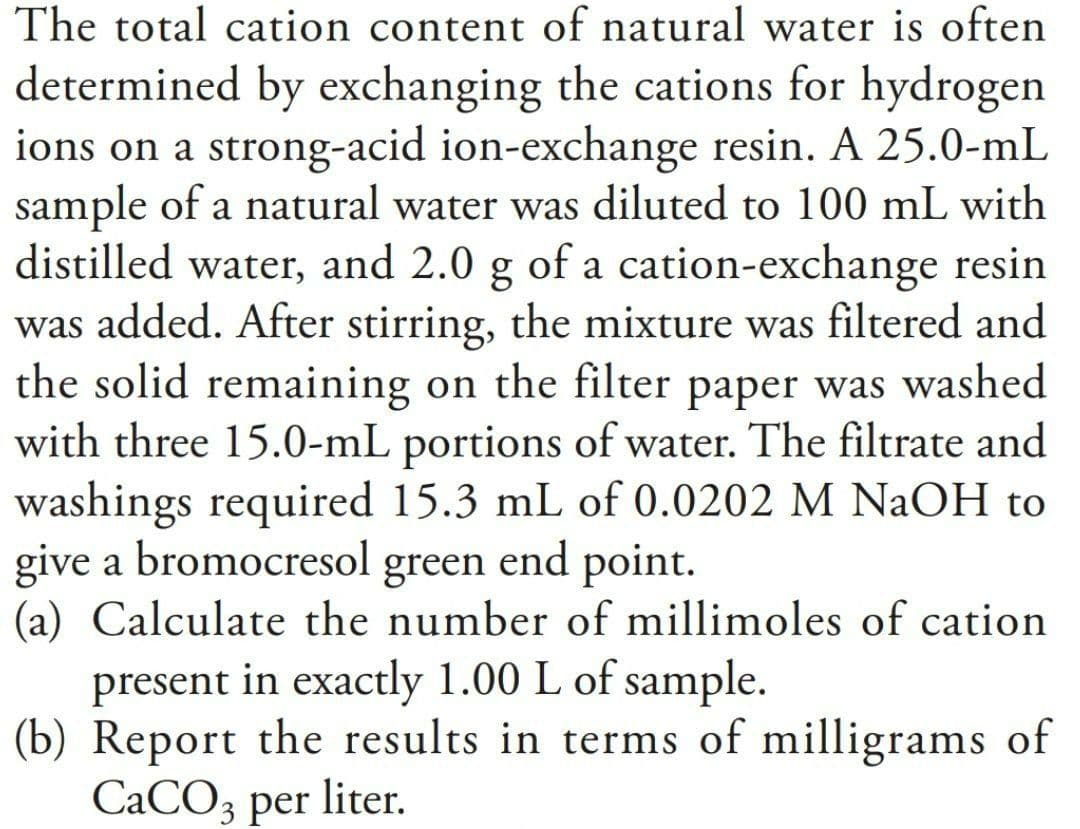The total cation content of natural water is often determined by exchanging the cations for hydrogen ions on a strong-acid ion-exchange resin. A 25.0-mL sample of a natural water was diluted to 100 mL with distilled water, and 2.0 g of a cation-exchange resin was added. After stirring, the mixture was filtered and the solid remaining on the filter paper was washed with three 15.0-mL portions of water. The filtrate and washings required 15.3 mL of 0.0202 M NaOH to give a bromocresol green end point. (a) Calculate the number of millimoles of cation present in exactly 1.00 L of sample. (b) Report the results in terms of milligrams of CaCO; per liter.
The total cation content of natural water is often determined by exchanging the cations for hydrogen ions on a strong-acid ion-exchange resin. A 25.0-mL sample of a natural water was diluted to 100 mL with distilled water, and 2.0 g of a cation-exchange resin was added. After stirring, the mixture was filtered and the solid remaining on the filter paper was washed with three 15.0-mL portions of water. The filtrate and washings required 15.3 mL of 0.0202 M NaOH to give a bromocresol green end point. (a) Calculate the number of millimoles of cation present in exactly 1.00 L of sample. (b) Report the results in terms of milligrams of CaCO; per liter.
Chapter31: Introduction To Analytical Separations
Section: Chapter Questions
Problem 31.19QAP
Related questions
Question
The total cation content of natural water is often determined by exchanging the cations for hydrogen ions on a strong-acid ion-exchange resin. A 25.0-mL sample of a natural water was diluted to 100 mL with distilled water, and 2.0 g of a cation-exchange resin was added. After stirring, the mixture was filtered and the solid remaining on the filter paper was washed with three 15.0-mL portions of water. The filtrate and washings required 15.3 mL of 0.0202 M NaOH to give a bromocresol green end point. (a) Calculate the number of millimoles of cation present in exactly 1.00 L of sample. (b) Report the results in terms of milligrams of CaCO; per liter.

Transcribed Image Text:The total cation content of natural water is often
determined by exchanging the cations for hydrogen
ions on a strong-acid ion-exchange resin. A 25.0-mL
sample of a natural water was diluted to 100 mL with
distilled water, and 2.0 g of a cation-exchange resin
was added. After stirring, the mixture was filtered and
the solid remaining on the filter paper was washed
with three 15.0-mL portions of water. The filtrate and
washings required 15.3 mL of 0.0202 M NaOH to
give a bromocresol green end point.
(a) Calculate the number of millimoles of cation
present in exactly 1.00 L of sample.
(b) Report the results in terms of milligrams of
СаСOз per liter.
Expert Solution
This question has been solved!
Explore an expertly crafted, step-by-step solution for a thorough understanding of key concepts.
This is a popular solution!
Trending now
This is a popular solution!
Step by step
Solved in 6 steps with 5 images

Knowledge Booster
Learn more about
Need a deep-dive on the concept behind this application? Look no further. Learn more about this topic, chemistry and related others by exploring similar questions and additional content below.Recommended textbooks for you

